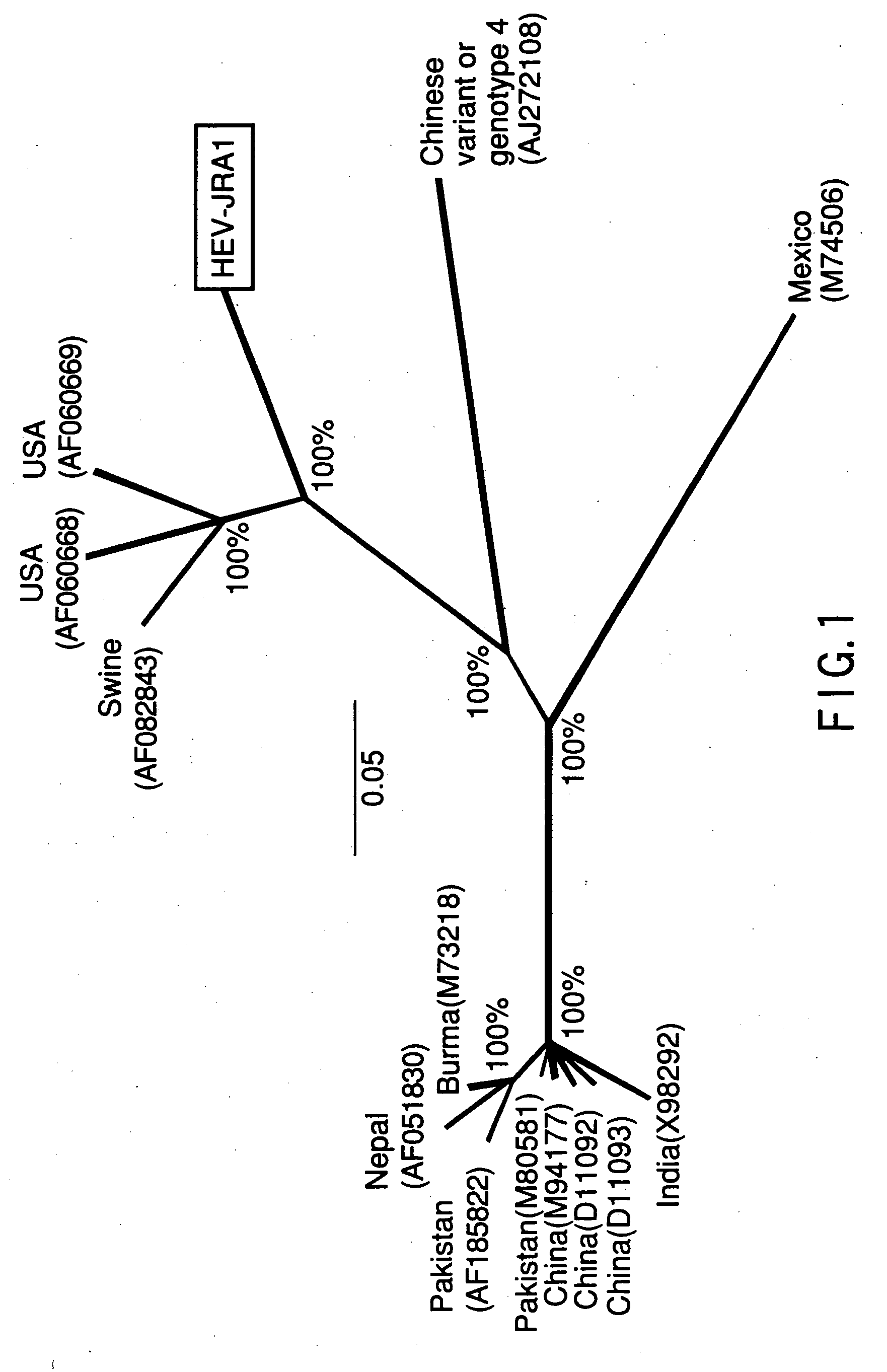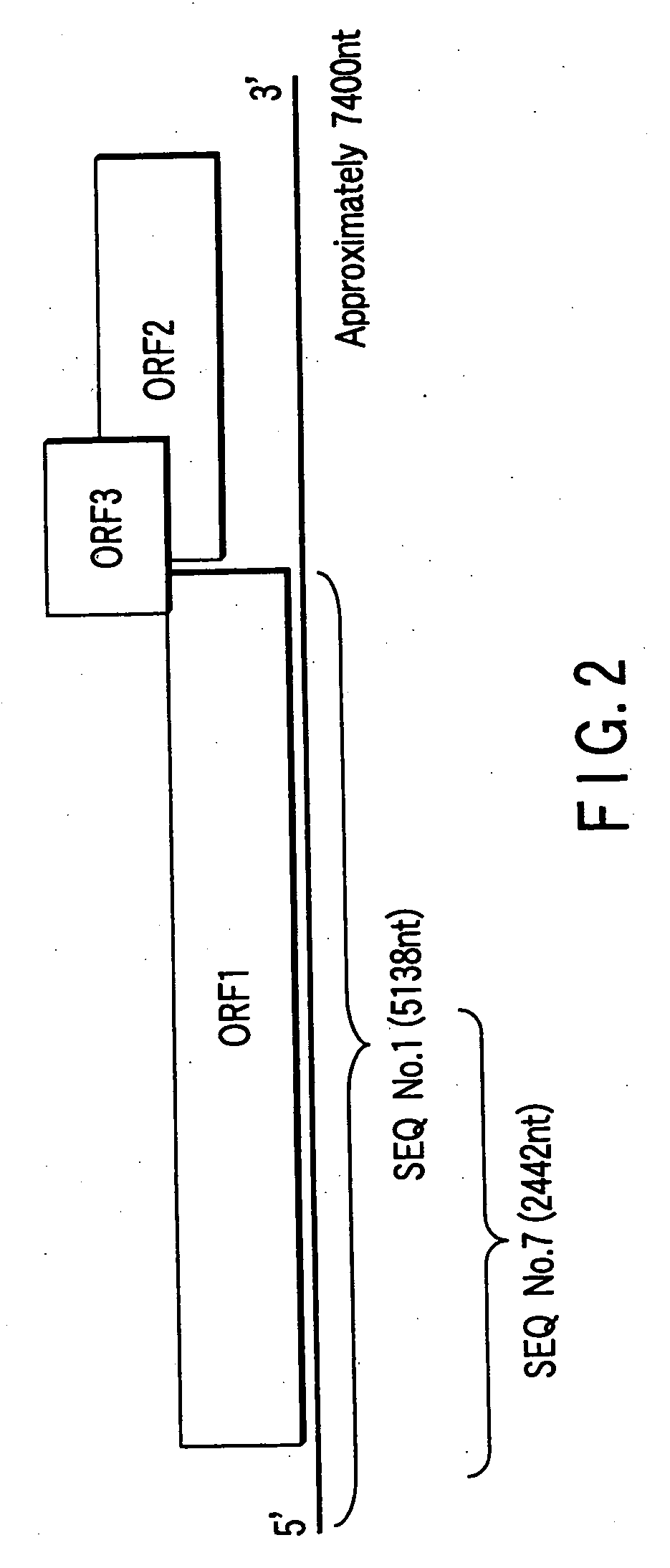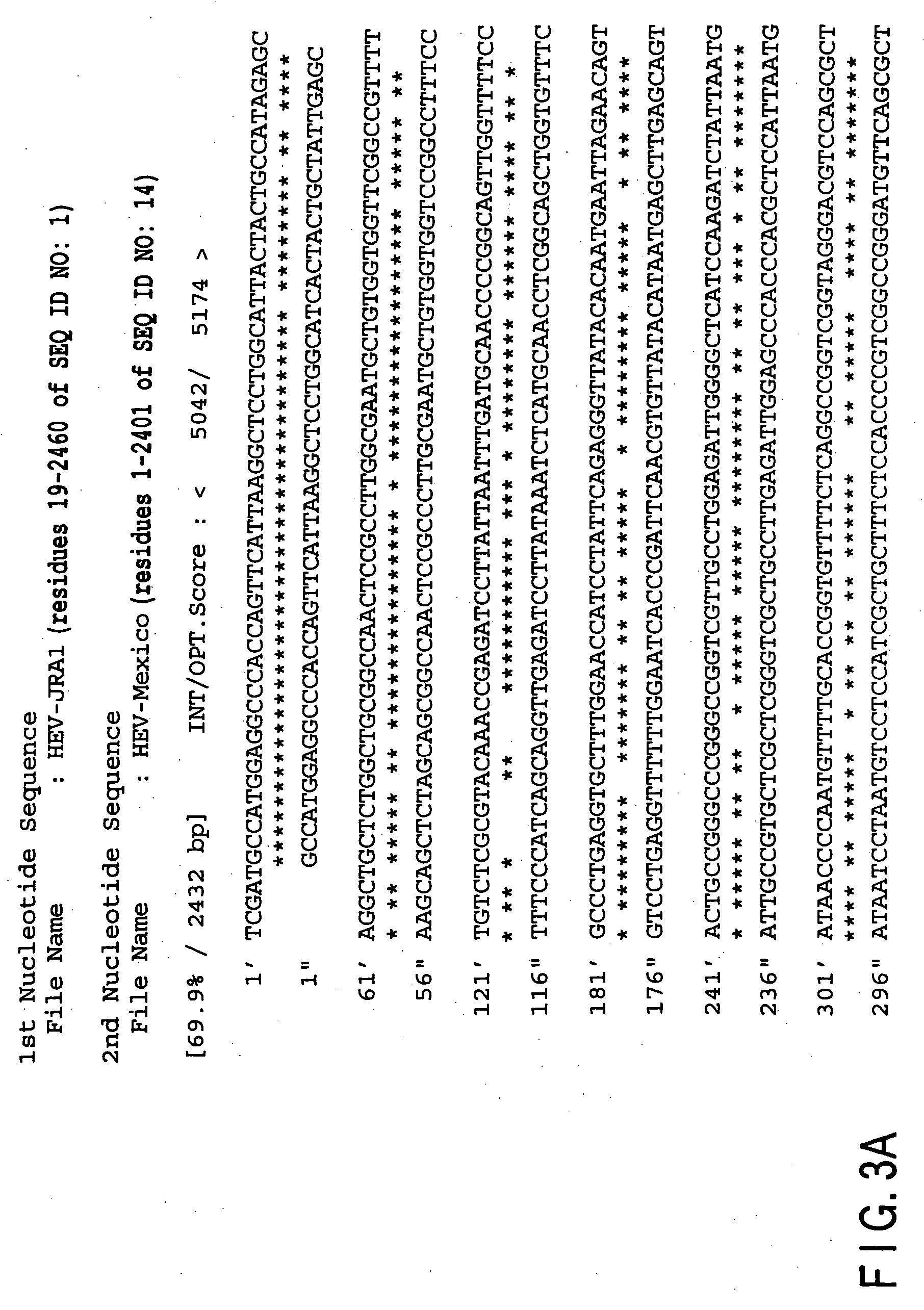Polynucleotide probe and primer derived from hepatitis E virus recovered from japanese, chip including the same, kit including the same, and method of detecting hepatitis E virus genome using the same
a technology of hepatitis e virus and polynucleotide probe, which is applied in the field of new methods for detecting hepatitis e virus, can solve the problems of strain not being revealed, significant possibility of virus inability to detect unknown viruses, and derived nucleotide sequences of hev genes, so as to improve the hev detection method and achieve the effect of simple and effective detection method, improved hev detection method, and improved detection efficiency
- Summary
- Abstract
- Description
- Claims
- Application Information
AI Technical Summary
Benefits of technology
Problems solved by technology
Method used
Image
Examples
example 1
Detection of HEV Genome RNA by RT-PCR Method
1. Primer
[0157] In the RT-PCR of the present example, four types of oligonucleotide primers respectively having following nucleotide sequences, selected from the nucleotide sequences derived from HEV-JRA1 disclosed at the SEQ No. 1 or the SEQ No. 2 of the sequence list, were used. [0158] #HE5-1 (5′-TCGATGCCATGGAGGCCCA-3′) (sense primer, which corresponds to nt 19-37 of the sequence list 1) (The underlined portion corresponds to the SEQ No. 2 of the sequence list) [0159] #HE5-2 (5′-GCCYTKGCGAATGCTGTGG-3′) (sense primer, which corresponds to nt 105-123 of the sequence list 1) (Y=C or T; K=G or T) (The underlined portion corresponds to the SEQ No. 3 of the sequence list) [0160] #HE5-3 (5′-TCRAARCAGTARGTGCGGTC-3′) (antisense primer, which corresponds to nt 450-469 of the sequence list 1) (R=A or G) (The underlined portion corresponds to the SEQ No. 4 of the sequence list) [0161] #HE5-4 (5′-CATAGCCTCSGCRACATCAG-3′) (antisense primer, which c...
example 2
Isolation of the Novel HEV Strain
[0166] Tests were conducted for seven acute hepatitis E patients of seven cases. Among the seven cases, the patients of five cases in which JHA-Sap, JKK-Sap, JKN-Sap, JMY-Haw and JSY-Sap were isolated had lived in Hokkaido. The patients of two cases in which JAK-Sai and JMM-Sai were isolated had lived in Saitama prefecture. Each patient developed the disease in an isolated manner i.e., with no contact with other patients regarding both time and place. Further, the case of each patient had nothing to do with any local epidemic of the disease. In six of the seven cases, patients had not been abroad recently. Only the patient from whom JMY-Haw was isolated had been to Hawaii as a tourist one month before developing the disease. The serum sample was collected from the patient at the acute state, frozen at a temperature of −20° C. or below and stored until the virological analysis was carried out.
[0167] The HEV sequence was determined, basically accordi...
example 3
Comprehensive Detection of HEV
[0171] First, blood was collected from a plurality of patients. Nucleic acid was extracted from 50 μL of the serum collected from each patient, by using SMITEST EX R & D (Genome Science Laboratories). 5′-gcagaccacrtatgtgktcg-3′(SEQ No. 32) and 5′-ccacrtatgtggtcgaygcc-3′(SEQ No. 33) as the sense primers, as well as 5′-acmarctgscgrggytgcat-3′(SEQ No. 34) and 5′-cgytgratwggrtgrttcca-3′(SEQ No. 35) as the antisense primers were added to each of the extracted nucleic acid. Each nucleic acid was reacted with the added sense primer and antisense primer at 37° C. for 30 minutes, under the presence of polymerase One-step RT.-PCR (Stratagene), whereby the synthesis of cDNA (i.e., the reaction of reverse transcription from RNA to DNA) was carried out.
[0172] Next, each of the cDNA synthesized as described above was subjected to nested PCR by using: Fast Start Taq DNA Polymerase (Roche Co., Ltd.); 5′-tgktcgaygccatggaggc-3′(SEQ No. 36), 5′-tgktcgaygccatggaggc-3′(SE...
PUM
| Property | Measurement | Unit |
|---|---|---|
| temperature | aaaaa | aaaaa |
| temperature | aaaaa | aaaaa |
| temperature | aaaaa | aaaaa |
Abstract
Description
Claims
Application Information
 Login to View More
Login to View More - R&D
- Intellectual Property
- Life Sciences
- Materials
- Tech Scout
- Unparalleled Data Quality
- Higher Quality Content
- 60% Fewer Hallucinations
Browse by: Latest US Patents, China's latest patents, Technical Efficacy Thesaurus, Application Domain, Technology Topic, Popular Technical Reports.
© 2025 PatSnap. All rights reserved.Legal|Privacy policy|Modern Slavery Act Transparency Statement|Sitemap|About US| Contact US: help@patsnap.com



